
 |
|
'Bright
Spot' on Ceres Has Dimmer
Companion
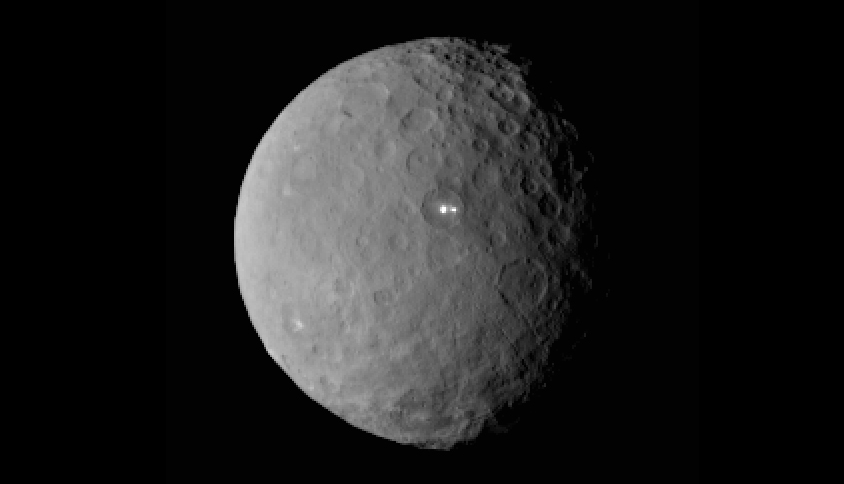 This image was taken by NASA's Dawn spacecraft of dwarf planet Ceres on Feb. 19 from a distance of nearly 29,000 miles (46,000 kilometers). It shows that the brightest spot on Ceres has a dimmer companion, which apparently lies in the same basin. Image Credit: NASA/JPL-Caltech/UCLA/MPS/DLR/IDA NASA Press Release February 25, 2015 Dwarf
planet Ceres continues to puzzle
scientists as NASA's Dawn
spacecraft gets closer to being
captured into orbit around the
object. The latest images from
Dawn, taken nearly 29,000 miles
(46,000 kilometers) from Ceres,
reveal that a bright spot that
stands out in previous images lies
close to yet another bright area.
"Ceres' bright spot can now be seen to have a companion of lesser brightness, but apparently in the same basin. This may be pointing to a volcano-like origin of the spots, but we will have to wait for better resolution before we can make such geologic interpretations," said Chris Russell, principal investigator for the Dawn mission, based at the University of California, Los Angeles. Using its ion propulsion system, Dawn will enter orbit around Ceres on March 6. As scientists receive better and better views of the dwarf planet over the next 16 months, they hope to gain a deeper understanding of its origin and evolution by studying its surface. The intriguing bright spots and other interesting features of this captivating world will come into sharper focus. "The brightest spot continues to be too small to resolve with our camera, but despite its size it is brighter than anything else on Ceres. This is truly unexpected and still a mystery to us," said Andreas Nathues, lead investigator for the framing camera team at the Max Planck Institute for Solar System Research, Gottingen, Germany. Dawn visited the giant asteroid Vesta from 2011 to 2012, delivering more than 30,000 images of the body along with many other measurements, and providing insights about its composition and geological history. Vesta has an average diameter of 326 miles (525 kilometers), while Ceres has an average diameter of 590 miles (950 kilometers). Vesta and Ceres are the two most massive bodies in the asteroid belt, located between Mars and Jupiter. Dawn's mission is managed by JPL for NASA's Science Mission Directorate in Washington. Dawn is a project of the directorate's Discovery Program, managed by NASA's Marshall Space Flight Center in Huntsville, Alabama. UCLA is responsible for overall Dawn mission science. Orbital ATK, Inc., in Dulles, Virginia, designed and built the spacecraft. The German Aerospace Center, the Max Planck Institute for Solar System Research, the Italian Space Agency and the Italian National Astrophysical Institute are international partners on the mission team. For a complete list of acknowledgements, visit: http://dawn.jpl.nasa.gov/mission 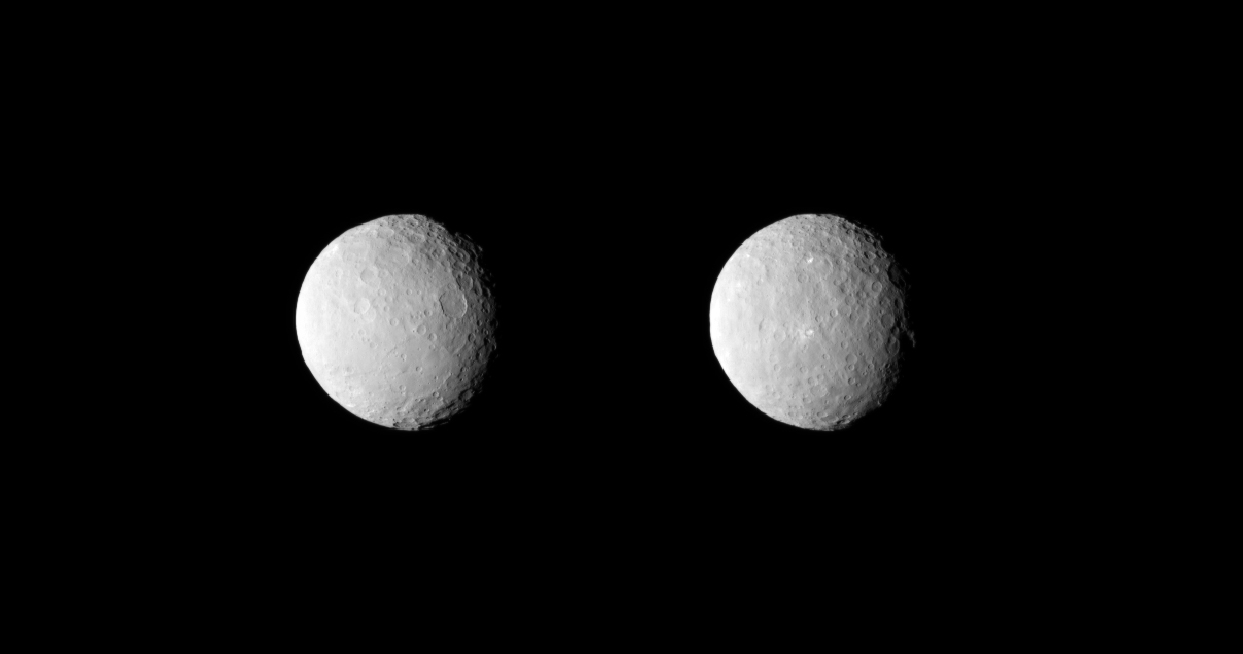 2
Views of Ceres on Approach,
Uncropped. Credit:
NASA/JPL-Caltech/UCLA/MPS/DLR/IDA
NASA's Dawn spacecraft obtained these uncropped images of dwarf planet Ceres on Feb. 19, 2015, from a distance of about 29,000 miles (46,000 kilometers). They are part of a series taken as Dawn observed Ceres completing one full rotation, which lasted about nine hours. The images show the full range of different crater shapes that can be found at Ceres' surface: From shallow, flattish craters to those with peaks at their centers. These views show sections of Ceres' surface that are similar to those in PIA19056 . Dawn is due to be captured into orbit around Ceres on March 6. 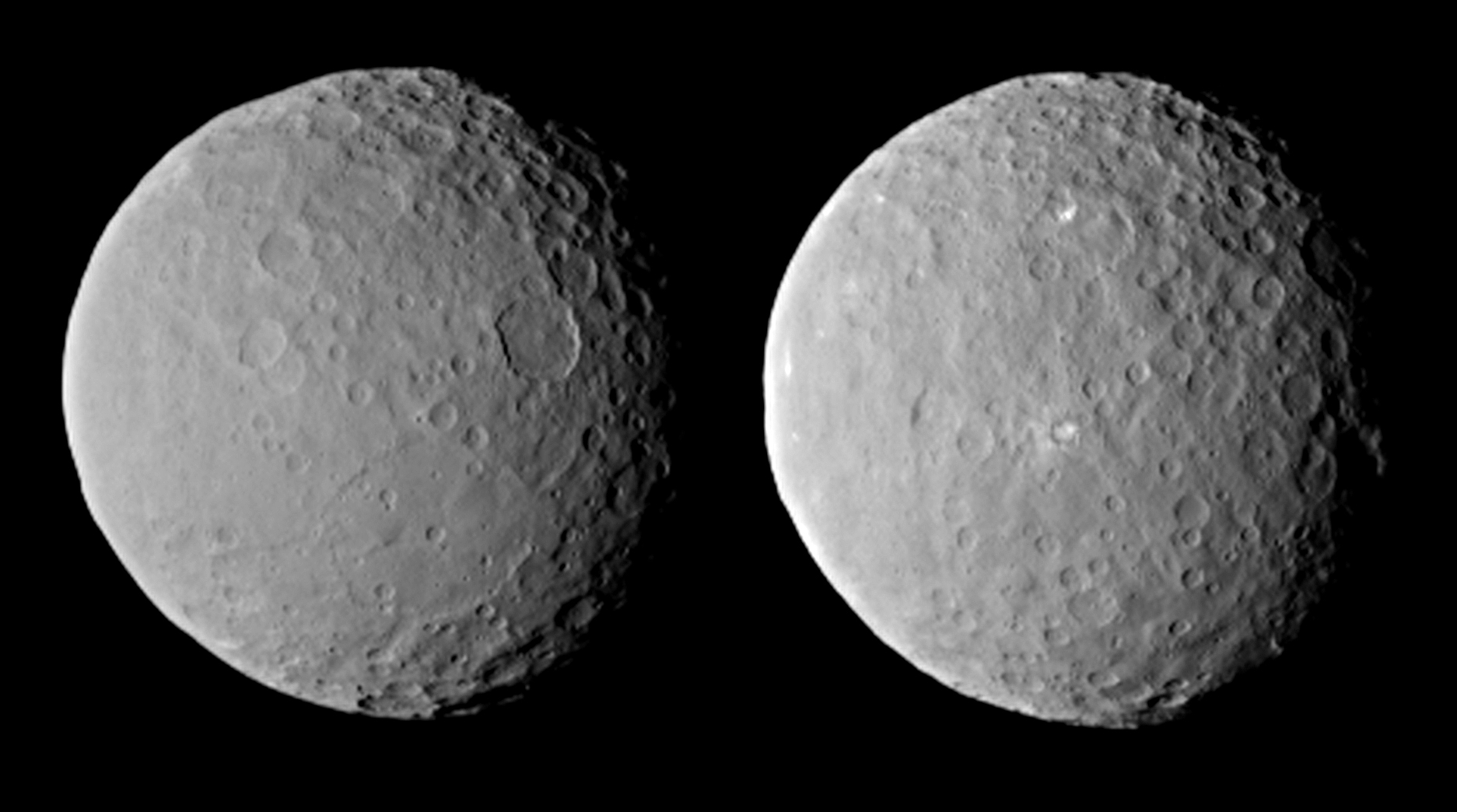 2
Views of Ceres on Approach,
Uncropped. Credit:
NASA/JPL-Caltech/UCLA/MPS/DLR/IDA
NASA's Dawn spacecraft obtained
these uncropped images These
images of dwarf planet Ceres,
processed to enhance clarity,
were taken on Feb. 19, 2015,
from a distance of about 29,000
miles (46,000 kilometers), by
NASA's Dawn spacecraft. Dawn
observed Ceres completing one
full rotation, which lasted
about nine hours.
The images show the full range of different crater shapes that can be found at Ceres' surface: From shallow, flattish craters to those with peaks at their centers. These views show sections of Ceres' surface that are similar to those in PIA19056. 'Bright Spot' on Ceres Has Dimmer Companion | Credit: NASA |
||||
|
NASA
Finds Mysterious Bright Spot on
Dwarf Planet Ceres: What Is It? 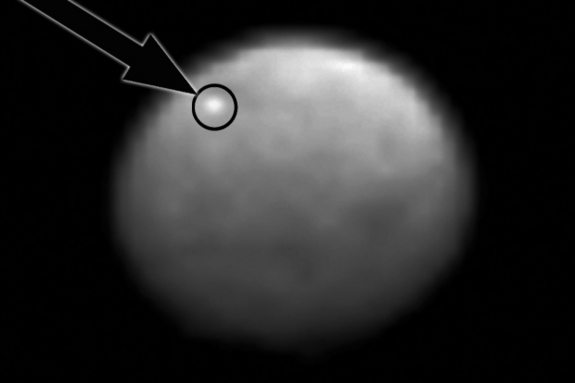 A mysterious white spot can be seen in the newest images from NASA's Dawn space telescope, which is rapidly approaching the dwarf planet. Credit: NASA/JPL-Caltech/UCLA/MPS/DLR/IDA/PS NASA Press Release February 25, 2015 A
strange, flickering white blotch
found on the dwarf planet Ceres by
a NASA spacecraft has scientists
scratching their heads.
The white spot on Ceres in a series of new photos taken on Jan. 13 by NASA's Dawn spacecraft, which is rapidly approaching the round dwarf planet in the asteroid belt between the orbits of Mars and Jupiter. But when the initial photo release on Monday (Jan. 19), the Dawn scientists gave no indication of what the white dot might be. "Yes, we can confirm that it is something on Ceres that reflects more sunlight, but what that is remains a mystery," Marc Rayman, mission director and chief engineer for the Dawn mission, told Space.com in an email SOURCE: Space.Com |
||||
 Additions by Russo, Pegasus
Team February 25, 2015 Additions by Russo, Pegasus
Team February 25, 2015Interesting news about Ceres. Now they see two "spotlights" in there. A dwarf planet is shining two bright lights at a NASA spacecraft right now, and our smartest scientists are unsure what they are. Well we shall see in the next months. Or not 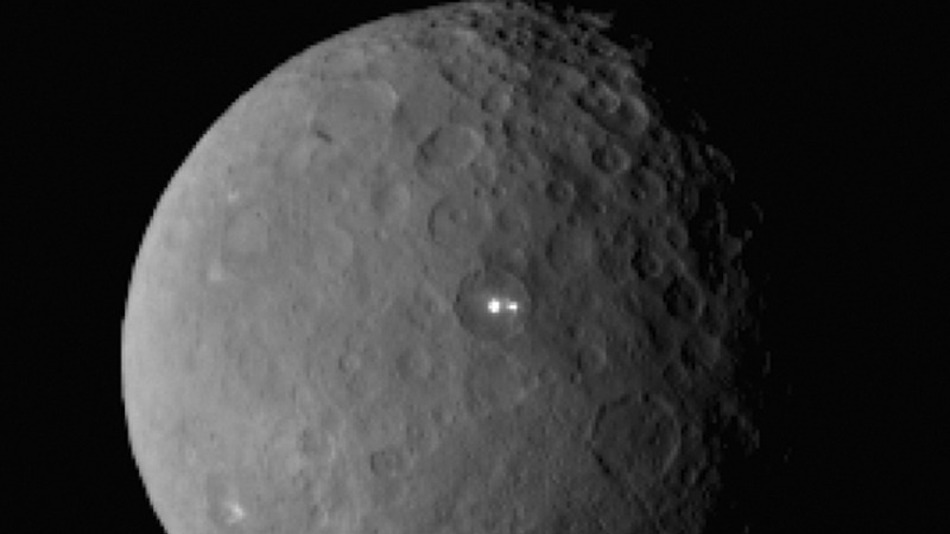 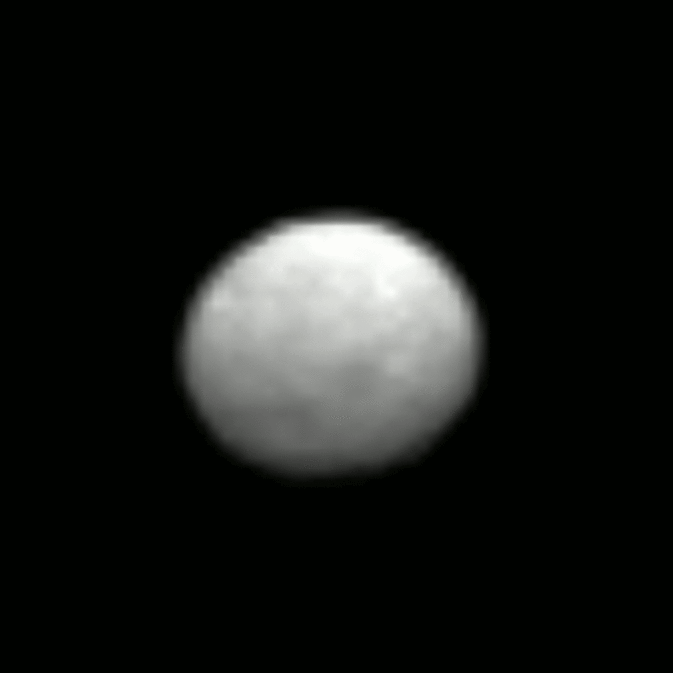  Quote
"This is truly unexpected and still a mystery to us," said Andreas Nathues, lead investigator for the framing camera team at the Max Planck Institute for Solar System Research in Gottingen, Germany, in a NASA statement. "The brightest spot [of the two] continues to be too small to resolve with our camera, but despite its size it is brighter than anything else on Ceres." 'Bright Spot' on Ceres Has Dimmer Companion Potential for extraterrestrial life: Although not as actively discussed as a potential home for extraterrestrial life as Mars, Titan or Europa, the presence of water ice has led to speculation that life may exist there, and that hypothesized ejecta could have come from Ceres to Earth. Ceres (dwarf planet) - Wikipedia |
||||
 Additions by Russo, Pegasus
Team May 14, 2015 Additions by Russo, Pegasus
Team May 14, 2015Thanks to user ZLD from HERE 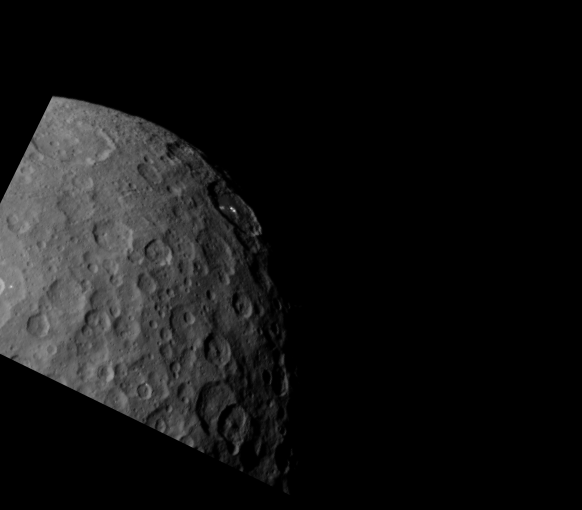 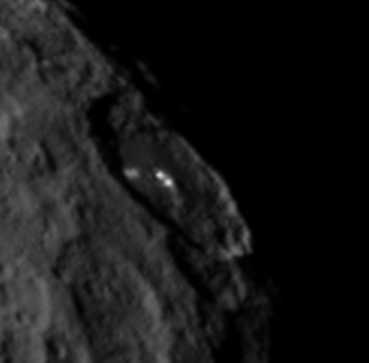 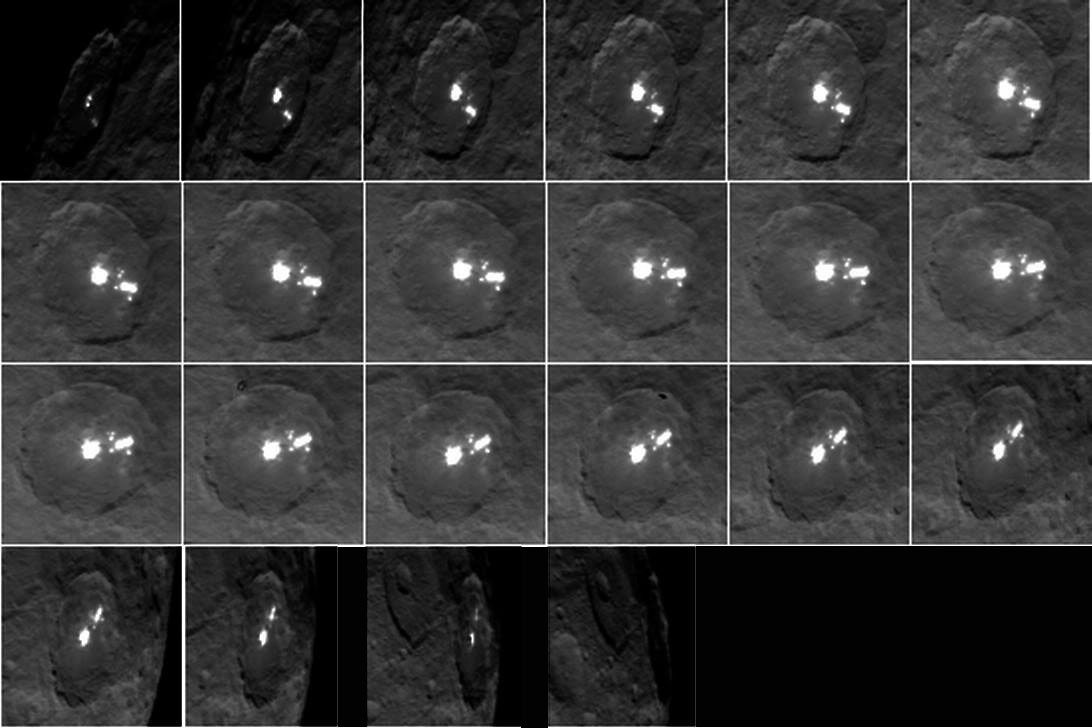 Montage Where
there were two, now there are 10! Ceres
photographed on May 3 and 4 by NASA’s Dawn
spacecraft show multiple white spots inside the
57-mile-wide crater located in the
asteroid’s northern hemisphere. Credit:
NASA/JPL-Caltech/UCLA/MPS/DLR/IDA / montage by
Tom Ruen ~ SOURCE
|
||||
|
NASA
PIA19547: Ceres RC3 Animation
This animation shows a sequence of images taken by NASA's Dawn spacecraft on May 4, 2015, from a distance of 8,400 miles (13,600 kilometers), in its RC3 mapping orbit. The image resolution is 0.8 mile (1.3 kilometers) per pixel. In this closest-yet view, the brightest spots within a crater in the northern hemisphere are revealed to be composed of many smaller spots. However, their exact nature remains unknown. Dawn's mission is managed by JPL for NASA's Science Mission Directorate in Washington. Dawn is a project of the directorate's Discovery Program, managed by NASA's Marshall Space Flight Center in Huntsville, Alabama. UCLA is responsible for overall Dawn mission science. Orbital ATK, Inc., in Dulles, Virginia, designed and built the spacecraft. The German Aerospace Center, the Max Planck Institute for Solar System Research, the Italian Space Agency and the Italian National Astrophysical Institute are international partners on the mission team. For a complete list of acknowledgements, visit http://dawn.jpl.nasa.gov/mission. For more information about the Dawn mission Image Credit: NASA/JPL-Caltech/UCLA/MPS/DLR/IDA Image Addition Date: 2015-05-11 |
||||
 Additions by Russo, Pegasus
Team June 05, 2015 Additions by Russo, Pegasus
Team June 05, 2015Revised Ceres map:  SOURCE Mission
Status Updates
- from Chief Engineer/ Mission Director, Marc Rayman (JPL) 2015 May 26, 2015 - Dawn Reaching to Lower Altitudes Dawn is following the carefully plotted trajectory around Ceres, maneuvering to prepare for its second mapping campaign next month. The probe's mapping orbits are nearly circular, but during the flight from one to another, the intermediate orbits are more elliptical. Tonight Dawn's complicated route will take it temporarily below the targeted mapping orbital altitude of 2,700 miles (4,400 kilometers). It will descend to 2,500 miles (4,100 kilometers) tomorrow before beginning another ascent. On May 22 Dawn photographed Ceres to help the navigation team maintain a tight fix on its orbital position. Controllers used the opportunity to acquire bonus visible and infrared spectra. NASA DAWN MISSION Mound:
 Here's another way of viewing the mound in RC3. Centered and rotated the frames to re-project a flyover of the area. The mound appears to be sitting on either highlands or an uplift of some sort. Interesting! SOURCE 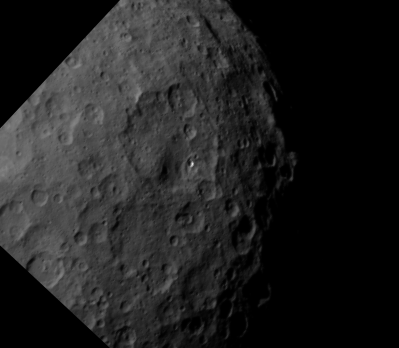 The "cone": This appears to be stranger than it first appeared to me. It almost seems to be a conical depression rather than a crater. Then, the bright areas appear to maybe even be flows from this depression. Maybe this is a ground level geyser? - SOURCE 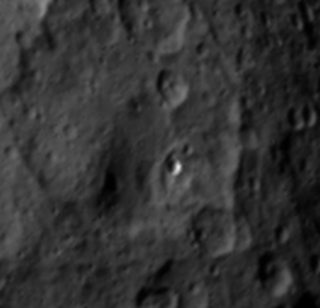 It seems dawn arrived the
the survey orbit. Time to keep
the eyes wide open for news.
Mission Status Updates - from Chief Engineer/ Mission Director, Marc Rayman (JPL) June 3, 2015 - Dawn Arrives in Second Mapping Orbit Dawn completed the maneuvering to reach its second mapping orbit and stopped ion-thrusting on schedule this morning. Since May 9, the spacecraft has reduced its orbital altitude from 8,400 miles (13,600 kilometers) to 2,700 miles (4,400 kilometers). The orbit period has correspondingly decreased from 15.2 days to 3.1 days. Dawn is scheduled to begin its new observations on June 5, as explained in the most recent Dawn Journal. First, however, the mission control team will measure the actual orbit parameters accurately and transmit them to the spacecraft. http://dawn.jpl.nasa.gov/mission/status.html Nice collage from an Italian user at NASA Blog: (click in the picture to enlarge)  Daniele
Bianchino says:
March 3, 2015 at 9:59 am Hello everyone, I am excited to new photos and for your great work; I’m very happy, and my question was read in the ” Dwarft planet arrival, nasa jpl, March 2? (latest Question) :-D This is my final collage, very accurate, I have represent in accurate scale Ceres, Vesta, the most important asteroids visited by a space probe, 3 icy moons (Mimas, Miranda, Enceladus), Mars moons (Phobos and Deimos) and the strange asteroid Chariklo (as I have imagined). I hope all like it. Daniele, Italy SOURCE |
||||
|
Fly
Over Dwarf Planet Ceres
Published on Jun 8, 2015 A new video animation of dwarf planet Ceres, based on images taken by NASA's Dawn spacecraft, provides dramatic flyover views of this heavily cratered, mysterious world. The images come from Dawn's first mapping orbit at Ceres, at an altitude of 8,400 mile (13,600 kilometers), as well as navigational images taken from 3,200 miles (5,100 kilometers) away. The images provided information for a three-dimensional terrain model. The vertical dimension has been exaggerated by a factor of two, and a star field has been added in the background. Fly Over Dwarf Planet Ceres - NASA Jet Propulsion Laboratory |
||||
 Additions
by Russo, Pegasus Team June 10, 2015 Additions
by Russo, Pegasus Team June 10, 2015Bright
Spots in Ceres' Second Mapping Orbit JUNE 10,
2015
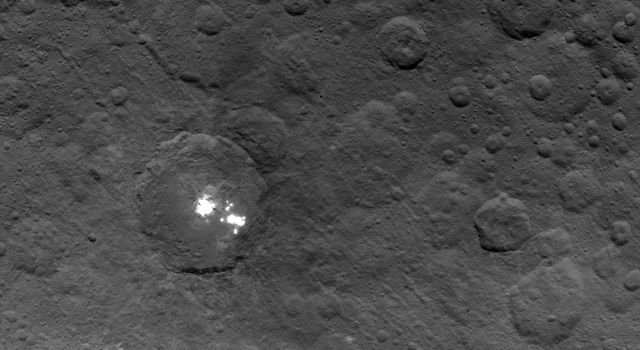
Also some interesting comments
taken from this forum:
unmannedspaceflight.com
Comment from Jaro_in_Montreal 

|
||||
 Additions by Russo, Pegasus
Team June 22, 2015 Additions by Russo, Pegasus
Team June 22, 2015Ceres
Spots Continue to Mystify in Latest Dawn Images
PIA19579: Dawn Survey Orbit Image 11
The closer we get to Ceres,
the more intriguing the distant dwarf planet
becomes. New images of Ceres from NASA's Dawn
spacecraft provide more clues about its mysterious
bright spots, and also reveal a pyramid-shaped
peak towering over a relatively flat landscape.
"The surface of Ceres has revealed many interesting and unique features. For example, icy moons in the outer solar system have craters with central pits, but on Ceres central pits in large craters are much more common. These and other features will allow us to understand the inner structure of Ceres that we cannot sense directly," said Carol Raymond, deputy principal investigator for the Dawn mission, based at NASA's Jet Propulsion Laboratory in Pasadena, California.
Original Caption Released with Image: A cluster of mysterious
bright spots on dwarf planet Ceres can be seen in
this image, taken by NASA's Dawn spacecraft from
an altitude of 2,700 miles (4,400 kilometers). The
image, with a resolution of 1,400 feet (410
meters) per pixel, was taken on June 9, 2015.
Dawn's mission is managed by JPL for NASA's Science Mission Directorate in Washington. Dawn is a project of the directorate's Discovery Program, managed by NASA's Marshall Space Flight Center in Huntsville, Alabama. UCLA is responsible for overall Dawn mission science. Orbital ATK, Inc., in Dulles, Virginia, designed and built the spacecraft. The German Aerospace Center, the Max Planck Institute for Solar System Research, the Italian Space Agency and the Italian National Astrophysical Institute are international partners on the mission team. For a complete list of acknowledgments, see http://dawn.jpl.nasa.gov/mission. Image Credit: NASA/JPL-Caltech/UCLA/MPS/DLR/IDA Image Addition Date: 2015-06-22 NASA PIA19579
Dawn has been studying the
dwarf planet in detail from its second mapping
orbit, which is 2,700 miles (4,400 kilometers)
above Ceres. A new view of its intriguing bright
spots, located in a crater about 55 miles (90
kilometers) across, shows even more small spots in
the crater than were previously visible.
At least eight spots can be seen next to the largest bright area, which scientists think is approximately 6 miles (9 kilometers) wide. A highly reflective material is responsible for these spots -- ice and salt are leading possibilities, but scientists are considering other options, too. Dawn's visible and infrared mapping spectrometer allows scientists to identify specific minerals present on Ceres by looking at how light is reflected. Each mineral reflects the range of visible and infrared-light wavelengths in a unique way, and this signature helps scientists determine the components of Ceres. So, as the spacecraft continues to send back more images and data, scientists will learn more about the mystery bright spots. In addition to the bright spots, the latest images also show a mountain with steep slopes protruding from a relatively smooth area of the dwarf planet's surface. The structure rises about 3 miles (5 kilometers) above the surface. Ceres also has numerous craters of varying sizes, many of which have central peaks. There is ample evidence of past activity on the surface, including flows, landslides and collapsed structures. It seems that Ceres shows more remnants of activity than the protoplanet Vesta, which Dawn studied intensively for 14 months in 2011 and 2012. Dawn is the first mission to visit a dwarf planet, and the first to orbit two distinct targets in our solar system. It arrived at Ceres, the largest object in the main asteroid belt between Mars and Jupiter, on March 6, 2015. Dawn will remain in its current altitude until June 30, continuing to take images and spectra of Ceres in orbits of about three days each. It then will move into its next orbit at an altitude of 900 miles (1,450 kilometers), arriving in early August. Dawn's mission is managed by JPL for NASA's Science Mission Directorate in Washington. Dawn is a project of the directorate's Discovery Program, managed by NASA's Marshall Space Flight Center in Huntsville, Alabama. UCLA is responsible for overall Dawn mission science. Orbital ATK Inc., in Dulles, Virginia, designed and built the spacecraft. The German Aerospace Center, Max Planck Institute for Solar System Research, Italian Space Agency and Italian National Astrophysical Institute are international partners on the mission team. NASA PRESS RELEASE JUNE 22, 2015
What are those
unusual bright spots on Ceres? Cast your vote
HERE
|
||||
Related Links
|
||||
|
All material on these pages, unless otherwise noted, is © Pegasus Research Consortium 2001-2019 |
 Webpages © 2001-2019 Pegasus Research Consortium |